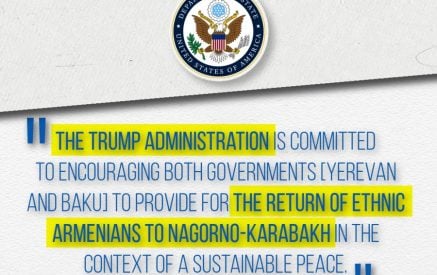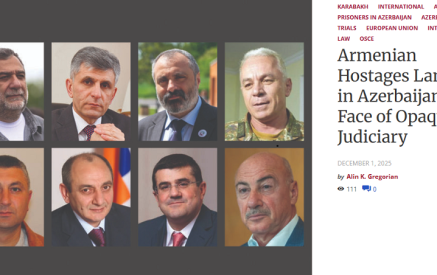USAID has Delivered only $2.5 Million in New Aid for Displaced Armenians from Artsakh
USAID Report Acknowledges “Acute Humanitarian Disaster,” Cites Ongoing Shelter, Protection, Health, and Food Security Needs
WASHINGTON, DC – A full year after Azerbaijan’s September 27, 2020 attack on Artsakh, a U.S. Agency for International Development (USAID) report to Congress failed to cite any direct U.S. assistance to at-risk families in Artsakh and a total of just $2.5 million in new USAID humanitarian aid to help Armenia deal with this ongoing crisis, reported the Armenian National Committee of America (ANCA).
Read also
In a two-page written response to Congresswoman Judy Chu (D-CA), USAID officials acknowledged the “acute humanitarian crisis” in Armenia caused by the displacement of 90,000 Armenians from Artsakh (Nagorno Karabakh). Rep. Chu’s request for clarification of the U.S. humanitarian response is among a broad array of bi-partisan Senate and House inquiries on the subject.
“The Biden Administration – a year after Azerbaijan’s attack – fails to cite even a single U.S. aid program in Artsakh – the target of 44 days of relentless aggression,” said ANCA Executive Director Aram Hamparian. “And, while finally acknowledging the ‘acute humanitarian crisis’ facing Armenia – this long-overdue USAID response reveals that the Administration’s actual spending falls far short of the level required to meet the very basic humanitarian needs – shelter, protection, health, and food security – that USAID itself has identified.”
Rep. Chu stressed, “Azerbaijan’s aggression has created lasting pain and damage in Artsakh. Armenians have lost their lives, homes, and land, while many are still separated from families or imprisoned by Azerbaijan. And on top of the hurt caused by Azerbaijan’s war, Armenians are continuing to struggle with the COVID-19 pandemic. I believe the US can and must stand with the Armenian people. That means increasing our support for refugees and reconstruction, and ensuring the resources to help Armenians address the coronavirus. I have spoken with USAID Administrator Samantha Power about this urgent need and will continue to press the Administration to act to provide this much-needed aid.”
The sum total of all U.S. State Department and USAID aid provided to all “people affected the fighting” – including both ethnic Armenians and Azerbaijanis represents a tiny fraction of the billions in U.S. emergency and humanitarian assistance distributed worldwide since the start of the Biden Administration.
Below find the full text of the USAID response to questions raised by Congresswoman Judy Chu, who has received an “A+” rating from the ANCA. Rep. Chu joined Rep. Jackie Speier (D-CA) in visiting Artsakh in 2019, and saw first-hand the importance of U.S.-funded demining efforts. Most recently, Rep. Chu supported a broad range of pro-Artsakh amendments to the FY2022 National Defense Authorization Act (NDAA), including, one calling on the State Department for a detailed report on all U.S. assistance to Artsakh and plans to expand such aid.
#####
USAID RESPONSE TO REP. JUDY CHU (D-CA)
Questions from the Office of Rep. Judy Chu
1. Updates on Admin (through USAID or other means) efforts to assess the scope and nature of humanitarian needs among Armenians in Artsakh
2. What’s being done to get aid to this population
3. What kind of Congressional action could help USAID meet these needs?
From the outset of last year’s fighting between Armenia and Azerbaijan in and around NK, the United States has responded to meet urgent humanitarian assistance needs for vulnerable populations fleeing the violence and the communities that host them. Throughout the crisis, USAID has continued to adapt its programming to effectively respond to the complex humanitarian crisis resulting from this fighting and assist the over 90,000 displaced persons that arrived in Armenia from NK.
The intensive fighting in the fall of 2020 sparked mass displacement of affected communities into Armenia, triggering an acute humanitarian crisis. Following the Ambassador’s October 9 disaster declaration, our Mission in Armenia provided an initial $100,000 in humanitarian assistance through partner Catholic Relief Services (CRS) and its local partner, Caritas Armenia, to distribute relief kits containing winter blankets, hygiene materials, and other items to affected populations in Armenia. On November 17th, Secretary Pompeo announced that the Department of State and USAID would provide $5 million in humanitarian assistance to support the operations of the International Committee of the Red Cross (ICRC) and other international and nongovernmental organization partners to assist people affected by the fighting. USAID’s Bureau for Humanitarian Assistance provided an additional $2.4 million to meet the immediate and acute humanitarian needs of those displaced by the violence in NK in Armenia. This amount, along with the initial $100,000, comprised USAID’s $2.5 million portion of the $5 million in new assistance. In total, USAID has provided over $4.5 million in new and repurposed assistance to respond to the complex humanitarian crisis resulting from the NK hostilities and the conflict-associated COVID-19 resurgence in Armenia.
USAID efforts complement other parts of the comprehensive U.S. emergency response to mitigate conflict-related impacts in and around NK. The U.S. Department of State’s component of this effort, led by the Bureau for Population, Refugees, and Migration (PRM), through ICRC, supported $2.5 million in emergency assistance to meet the acute and ongoing humanitarian needs of populations impacted by the fighting in and around NK. USAID has not had any active programming in NK since March 31, 2020. From 1998 to 2020, USAID provided more than $48 million in assistance for NK. USAID is coordinating closely with the Department of State and interagency partners regarding the provision of humanitarian assistance to populations affected by the fighting in and around NK. The Department and USAID are also assessing needs as we consider additional opportunities for assistance to NK. In some cases this may include clarifying outstanding questions that bear on our ability to fund new programs there, including whether implementing partners would have reliable access to NK as well as the implications of the Russian presence in NK.
In Armenia, an estimated 37,000 ethnic Armenians displaced from NK face ongoing shelter, protection, health (including mental health), and food security needs. Of the more than 90,000 people displaced to Armenia by the fighting last fall, an estimated 30,000 are expected to remain in Armenia permanently. These remaining populations will need long-term integration assistance.
Significant challenges that inhibit humanitarian assistance efforts in and around NK remain. Many humanitarian organizations, including UN agencies, have been blocked from accessing vulnerable populations in the area, further complicating efforts to provide needed assistance. As the displacement situation continues to evolve, USAID is working closely with the Department of State to assess post-conflict humanitarian needs and possible future U.S. engagement. We anticipate that the focus of USAID assistance will transition from emergency humanitarian assistance to longer-term recovery and integration of displaced persons in Armenia.
Going forward, in addition to coordination with our interagency and donor partners, USAID will continue to track conflict-related displacement and humanitarian needs and opportunities to support the safe, voluntary, and dignified return of displaced populations to their home communities as conditions allow. The United States remains committed to helping foster a more stable and peaceful future for all the people of the region, including in NK.
























































